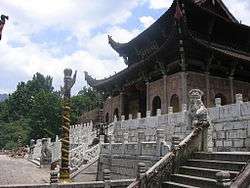Hall of Kshitigarbha
| Hall of Kshitigarbha | |||||||
|
The Hall of Kshitigarbha at Roushen Temple, in Mount Jiuhua, Anhui, China. | |||||||
| Traditional Chinese | 地藏殿 | ||||||
|---|---|---|---|---|---|---|---|
| Simplified Chinese | 地藏殿 | ||||||
| Literal meaning | Hall of Kshitigarbha | ||||||
| |||||||
The Hall of Kshitigarbha or Hall of Kshitigarbha Hall (Chinese: 地藏殿; pinyin: Dìzàngdiàn) is the most important annex halls in Chinese Buddhist temples and Kshitigarbha is enshrined in it.[1]
According to kṣitigarbha bodhisattva pūrvapraṇidhāna sūtra (《地藏菩薩本願經》), the Chinese name of Kshitigarbha "Dizang" is derived from Dizang Shilun sūtra (《地藏十輪經》): "Kshitigarbha is patient and generous as the ground and as thoughtful and peaceful as treasure" (安忍不動如大地,靜慮深密如秘藏). By Sakyamuni Buddha's exhortions, Kshitigarbha has to cultivate all the living creatures and eliminate all sufferings in the period from Sakyamuni's Parinivana to Maitreya's birth. Kshitigarbha has made vows "Before the hell is empty, I will not become Buddha. After all sentient beings are saved, will I attain Buddhahood" (地獄不空,誓不成佛。眾生度盡,方證菩提。); "If not me going to hell, who will go there?" (我不入地獄,誰入地獄?) Therefore he gets the name of "first in compassion and vows" and is worshiped by people since the ancient times.[2][3]
Kshitigarbha 's statue is generally a monk who wears a robe, bald or in a vishnu lou cap, sits in lotus posture with a Khakkhara in his left hand, symbolizing love for all living creations and strict precepts. In his right hand is a ruyi, signifying to fulfill the wishes of all living creatures. Some are standing statue of Kshitigarbha with his disciples, Daoming (道明), a Bhikkhu who stands to his left, and Mingong (憫公), an old man on the right. In some larger Buddhist temples, statues of ten King Yamas who are in charge of the Diyu (sheol) in hell for dead people.[1]
References
- 1 2 Zi Yan (2012-08-01). Famous Temples in China. Beijing: Time Publishing and Media Co., Ltd. pp. 39–40. ISBN 978-7-5461-3146-7.
- ↑ Wei Ran (2012-06-01). Buddhist Buildings. Beijing: China Architecture & Building Press. ISBN 9787112142880.
- ↑ Han Xin (2006-04-01). Well-Known Temples of China. Shanghai: The Eastern Publishing Co. Ltd. ISBN 7506024772.
Further reading
| Wikimedia Commons has media related to Kshitigarbha Halls. |
- Wang Guixiang (2016-06-17). 《中国汉传佛教建筑史——佛寺的建造、分布与寺院格局、建筑类型及其变迁》 [The History of Chinese Buddhist Temples] (in Chinese). Beijing: Tsinghua University Press. ISBN 9787302427056.
- Zhang Yuhuan (2014-06-01). 《图解中国佛教建筑、寺院系列》 (in Chinese). Beijing: Contemporary China Publishing House. ISBN 9787515401188.
